weight Alfa Romeo 156 2005 Owner handbook (in English)
[x] Cancel search | Manufacturer: ALFA ROMEO, Model Year: 2005, Model line: 156, Model: Alfa Romeo 156 2005Pages: 357, PDF Size: 5.04 MB
Page 38 of 357
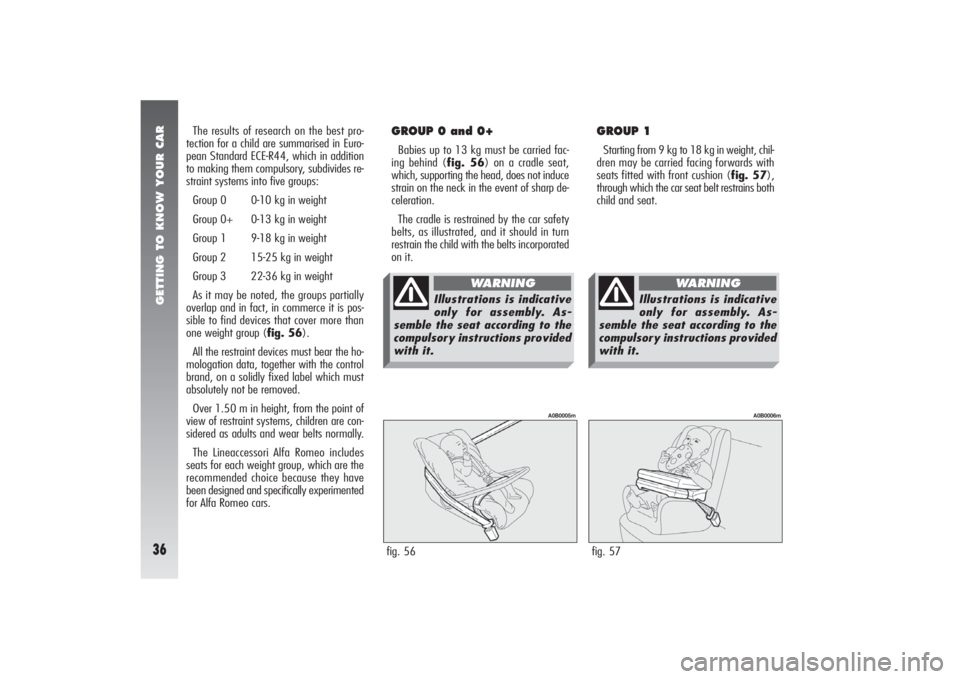
GETTING TO KNOW YOUR CAR36
The results of research on the best pro-
tection for a child are summarised in Euro-
pean Standard ECE-R44, which in addition
to making them compulsory, subdivides re-
straint systems into five groups:
Group 0 0-10 kg in weight
Group 0+ 0-13 kg in weight
Group 1 9-18 kg in weight
Group 2 15-25 kg in weight
Group 3 22-36 kg in weight
As it may be noted, the groups partially
overlap and in fact, in commerce it is pos-
sible to find devices that cover more than
one weight group (fig. 56).
All the restraint devices must bear the ho-
mologation data, together with the control
brand, on a solidly fixed label which must
absolutely not be removed.
Over 1.50 m in height, from the point of
view of restraint systems, children are con-
sidered as adults and wear belts normally.
The Lineaccessori Alfa Romeo includes
seats for each weight group, which are the
recommended choice because they have
been designed and specifically experimented
for Alfa Romeo cars.
GROUP 0 and 0+Babies up to 13 kg must be carried fac-
ing behind (fig. 56) on a cradle seat,
which, supporting the head, does not induce
strain on the neck in the event of sharp de-
celeration.
The cradle is restrained by the car safety
belts, as illustrated, and it should in turn
restrain the child with the belts incorporated
on it.fig. 56
A0B0005m
GROUP 1Starting from 9 kg to 18 kg in weight, chil-
dren may be carried facing forwards with
seats fitted with front cushion (fig. 57),
through which the car seat belt restrains both
child and seat.fig. 57
A0B0006m
Illustrations is indicative
only for assembly. As-
semble the seat according to the
compulsory instructions provided
with it.
WARNING
Illustrations is indicative
only for assembly. As-
semble the seat according to the
compulsory instructions provided
with it.
WARNING
Page 39 of 357
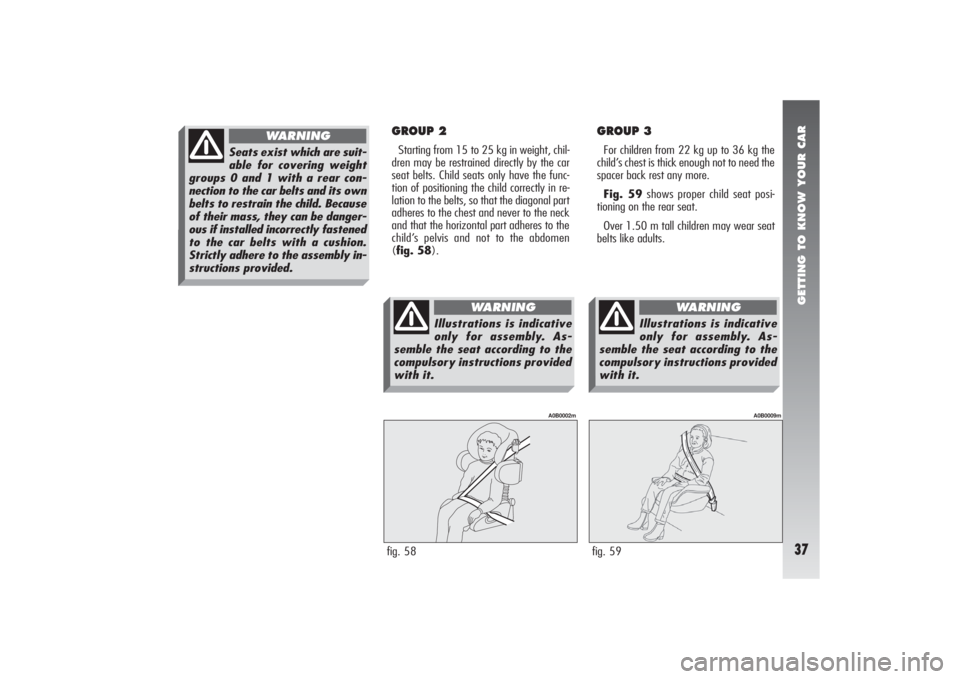
GETTING TO KNOW YOUR CAR37
GROUP 3For children from 22 kg up to 36 kg the
child’s chest is thick enough not to need the
spacer back rest any more.
Fig. 59shows proper child seat posi-
tioning on the rear seat.
Over 1.50 m tall children may wear seat
belts like adults.
GROUP 2Starting from 15 to 25 kg in weight, chil-
dren may be restrained directly by the car
seat belts. Child seats only have the func-
tion of positioning the child correctly in re-
lation to the belts, so that the diagonal part
adheres to the chest and never to the neck
and that the horizontal part adheres to the
child’s pelvis and not to the abdomen
(fig. 58).fig. 58
A0B0002m
fig. 59
A0B0009m
Seats exist which are suit-
able for covering weight
groups 0 and 1 with a rear con-
nection to the car belts and its own
belts to restrain the child. Because
of their mass, they can be danger-
ous if installed incorrectly fastened
to the car belts with a cushion.
Strictly adhere to the assembly in-
structions provided.
WARNING
Illustrations is indicative
only for assembly. As-
semble the seat according to the
compulsory instructions provided
with it.
WARNING
Illustrations is indicative
only for assembly. As-
semble the seat according to the
compulsory instructions provided
with it.
WARNING
Page 40 of 357
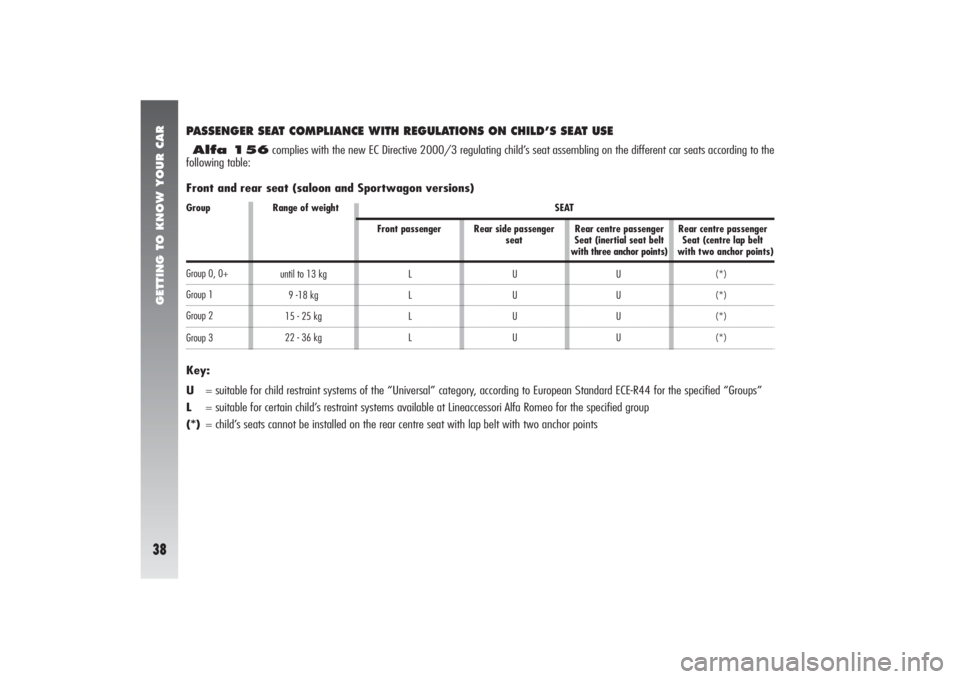
GETTING TO KNOW YOUR CAR38
Group 0, 0+Group 1Group 2Group 3 PASSENGER SEAT COMPLIANCE WITH REGULATIONS ON CHILD’S SEAT USEAlfa 156complies with the new EC Directive 2000/3 regulating child’s seat assembling on the different car seats according to the
following table:
Front and rear seat (saloon and Sportwagon versions)
Key:
U= suitable for child restraint systems of the “Universal” category, according to European Standard ECE-R44 for the specified “Groups”
L= suitable for certain child’s restraint systems available at Lineaccessori Alfa Romeo for the specified group
(*)= child’s seats cannot be installed on the rear centre seat with lap belt with two anchor points
U
U
U
U(*)
(*)
(*)
(*) U
U
U
U L
L
L
L until to 13 kg
9 -18 kg
15 - 25 kg
22 - 36 kg
Group Range of weight SEAT
Front passenger Rear side passenger Rear centre passenger Rear centre passenger
seat Seat (inertial seat belt Seat (centre lap belt
with three anchor points) with two anchor points)
Page 41 of 357
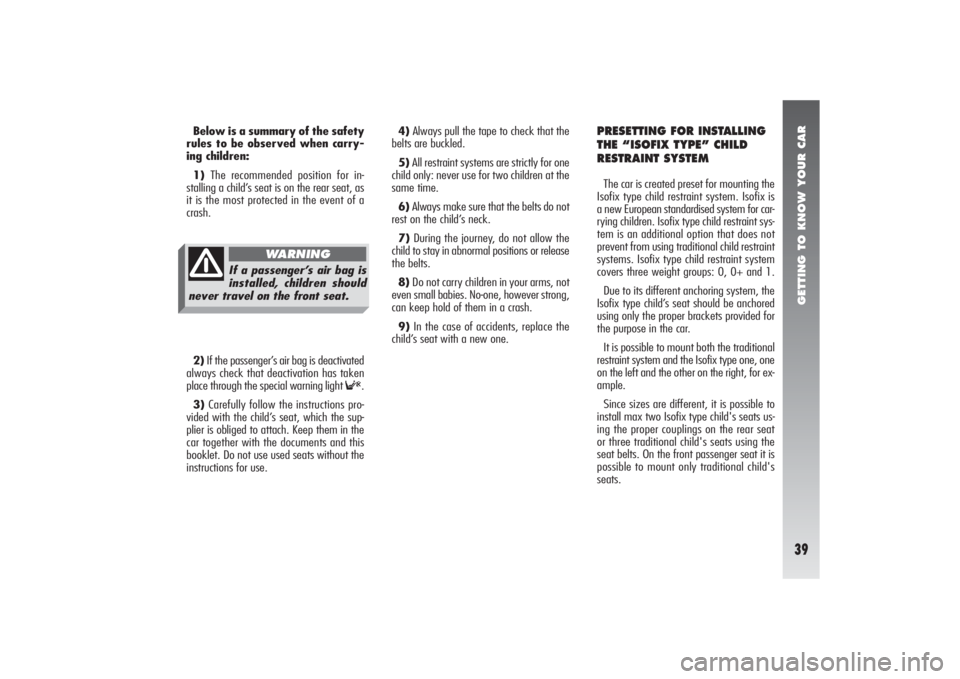
GETTING TO KNOW YOUR CAR39
4)Always pull the tape to check that the
belts are buckled.
5)All restraint systems are strictly for one
child only: never use for two children at the
same time.
6)Always make sure that the belts do not
rest on the child’s neck.
7)During the journey, do not allow the
child to stay in abnormal positions or release
the belts.
8)Do not carry children in your arms, not
even small babies. No-one, however strong,
can keep hold of them in a crash.
9)In the case of accidents, replace the
child’s seat with a new one.
PRESETTING FOR INSTALLING
THE “ISOFIX TYPE” CHILD
RESTRAINT SYSTEMThe car is created preset for mounting the
Isofix type child restraint system. Isofix is
a new European standardised system for car-
rying children. Isofix type child restraint sys-
tem is an additional option that does not
prevent from using traditional child restraint
systems. Isofix type child restraint system
covers three weight groups: 0, 0+ and 1.
Due to its different anchoring system, the
Isofix type child’s seat should be anchored
using only the proper brackets provided for
the purpose in the car.
It is possible to mount both the traditional
restraint system and the Isofix type one, one
on the left and the other on the right, for ex-
ample.
Since sizes are different, it is possible to
install max two Isofix type child's seats us-
ing the proper couplings on the rear seat
or three traditional child's seats using the
seat belts. On the front passenger seat it is
possible to mount only traditional child's
seats. Below is a summary of the safety
rules to be observed when carry-
ing children:
1)The recommended position for in-
stalling a child’s seat is on the rear seat, as
it is the most protected in the event of a
crash.
2)If the passenger’s air bag is deactivated
always check that deactivation has taken
place through the special warning light
F
.
3)Carefully follow the instructions pro-
vided with the child’s seat, which the sup-
plier is obliged to attach. Keep them in the
car together with the documents and this
booklet. Do not use used seats without the
instructions for use.
If a passenger’s air bag is
installed, children should
never travel on the front seat.
WARNING
Page 42 of 357
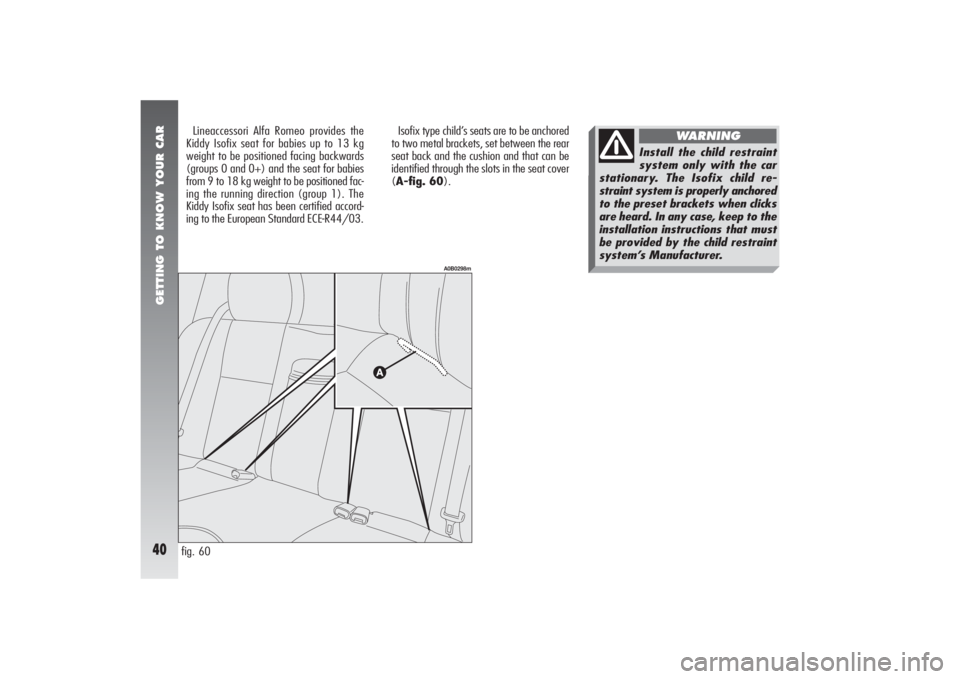
GETTING TO KNOW YOUR CAR40
fig. 60Isofix type child’s seats are to be anchored
to two metal brackets, set between the rear
seat back and the cushion and that can be
identified through the slots in the seat cover
(A-fig. 60). Lineaccessori Alfa Romeo provides the
Kiddy Isofix seat for babies up to 13 kg
weight to be positioned facing backwards
(groups 0 and 0+) and the seat for babies
from 9 to 18 kg weight to be positioned fac-
ing the running direction (group 1). The
Kiddy Isofix seat has been certified accord-
ing to the European Standard ECE-R44/03.
A0B0298m
Install the child restraint
system only with the car
stationary. The Isofix child re-
straint system is properly anchored
to the preset brackets when clicks
are heard. In any case, keep to the
installation instructions that must
be provided by the child restraint
system’s Manufacturer.
WARNING
Page 43 of 357
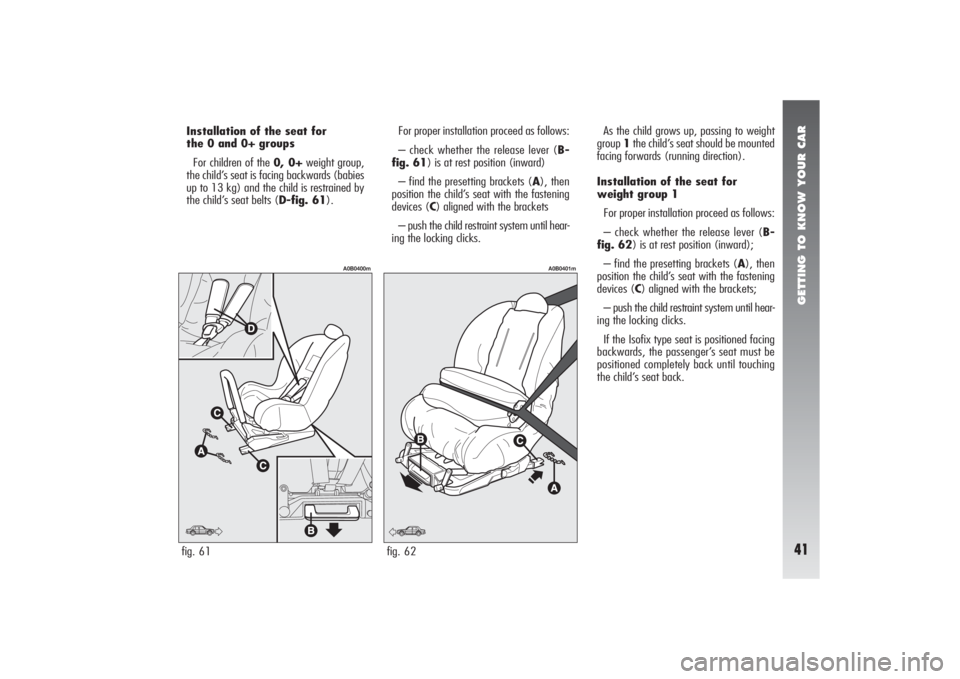
GETTING TO KNOW YOUR CAR41
For proper installation proceed as follows:
– check whether the release lever (B-
fig. 61) is at rest position (inward)
– find the presetting brackets (A), then
position the child’s seat with the fastening
devices (C) aligned with the brackets
– push the child restraint system until hear-
ing the locking clicks.As the child grows up, passing to weight
group 1the child’s seat should be mounted
facing forwards (running direction).
Installation of the seat for
weight group 1
For proper installation proceed as follows:
– check whether the release lever (B-
fig. 62) is at rest position (inward);
– find the presetting brackets (A), then
position the child’s seat with the fastening
devices (C) aligned with the brackets;
– push the child restraint system until hear-
ing the locking clicks.
If the Isofix type seat is positioned facing
backwards, the passenger’s seat must be
positioned completely back until touching
the child’s seat back. Installation of the seat for
the 0 and 0+ groups
For children of the 0, 0+weight group,
the child’s seat is facing backwards (babies
up to 13 kg) and the child is restrained by
the child’s seat belts (D-fig. 61).
fig. 61
A0B0400m
fig. 62
A0B0401m
Page 198 of 357
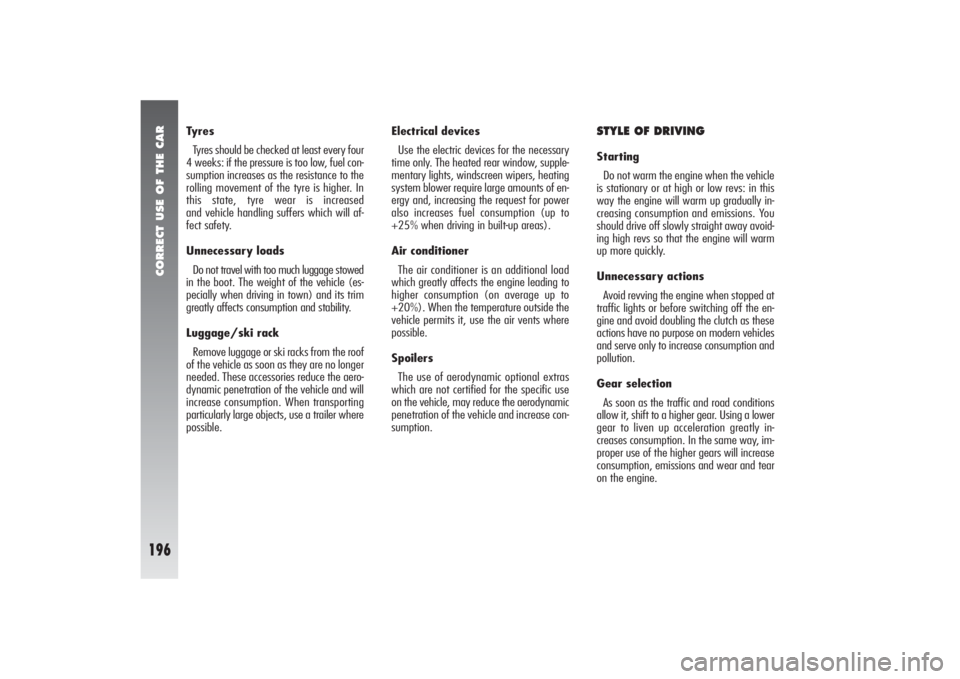
CORRECT USE OF THE CAR
196
Tyres
Tyres should be checked at least every four
4 weeks: if the pressure is too low, fuel con-
sumption increases as the resistance to the
rolling movement of the tyre is higher. In
this state, tyre wear is increased
and vehicle handling suffers which will af-
fect safety.
Unnecessary loads
Do not travel with too much luggage stowed
in the boot. The weight of the vehicle (es-
pecially when driving in town) and its trim
greatly affects consumption and stability.
Luggage/ski rack
Remove luggage or ski racks from the roof
of the vehicle as soon as they are no longer
needed. These accessories reduce the aero-
dynamic penetration of the vehicle and will
increase consumption. When transporting
particularly large objects, use a trailer where
possible.Electrical devices
Use the electric devices for the necessary
time only. The heated rear window, supple-
mentary lights, windscreen wipers, heating
system blower require large amounts of en-
ergy and, increasing the request for power
also increases fuel consumption (up to
+25% when driving in built-up areas).
Air conditioner
The air conditioner is an additional load
which greatly affects the engine leading to
higher consumption (on average up to
+20%). When the temperature outside the
vehicle permits it, use the air vents where
possible.
Spoilers
The use of aerodynamic optional extras
which are not certified for the specific use
on the vehicle, may reduce the aerodynamic
penetration of the vehicle and increase con-
sumption.
STYLE OF DRIVINGStarting
Do not warm the engine when the vehicle
is stationary or at high or low revs: in this
way the engine will warm up gradually in-
creasing consumption and emissions. You
should drive off slowly straight away avoid-
ing high revs so that the engine will warm
up more quickly.
Unnecessary actions
Avoid revving the engine when stopped at
traffic lights or before switching off the en-
gine and avoid doubling the clutch as these
actions have no purpose on modern vehicles
and serve only to increase consumption and
pollution.
Gear selection
As soon as the traffic and road conditions
allow it, shift to a higher gear. Using a lower
gear to liven up acceleration greatly in-
creases consumption. In the same way, im-
proper use of the higher gears will increase
consumption, emissions and wear and tear
on the engine.
Page 201 of 357

CORRECT USE OF THE CAR
199
TOWING TRAILERSWARNINGS AND
SUGGESTIONS For towing caravans or trailers the vehi-
cle must be fitted with a certified tow hook
and an adequate electric system. Installa-
tion should be carried out by specialised per-
sonnel who release a special document for
circulation on the road.
Install any specific and/or additional rear-
view mirrors as specified by law. Remember
that when towing a trailer, steep hills are
harder to climb, the braking spaces increase
and overtaking takes longer depending on
the overall weight.
Engage a low gear when driving downhill,
rather than constantly using the brake.
The weight the trailer exerts on the vehi-
cle tow hook reduces by the same amount
the actual vehicle loading capacity. To make sure the maximum towable
weight is not exceeded (given in the log
book) account should be taken of the fully
laden trailer, including accessories and per-
sonal belongings.
Drive within the permitted speed limits for
vehicles with trailers. In any case the maxi-
mum speed should never exceed 100 km/h.
INSTALLING THE TOW HOOKThe towing device should be fastened to
the body by specialised personnel according
to the following instructions and any addi-
tional and/or integrative information sup-
plied by the Manufacturer of the device.
The towing device must meet current reg-
ulations with reference to 94/20/EC Di-
rective and subsequent amendments.
For any version the towing device used
must match the towable weight of the ve-
hicle on which it is to be installed.
For the electric connection a unified con-
nector should be used which is generally
placed on a special bracket normally fas-
tened to the towing device.
The ABS system with
which the car may be fitted
does not control the trailer braking
system. Particular care is therefore
necessary on slippery surfaces.
WARNING
Under no circumstances
should the vehicle brake
system be altered to control the
trailer brake. The trailer braking
system must be fully independent
of the vehicle’s hydraulic system.
WARNING
Page 284 of 357
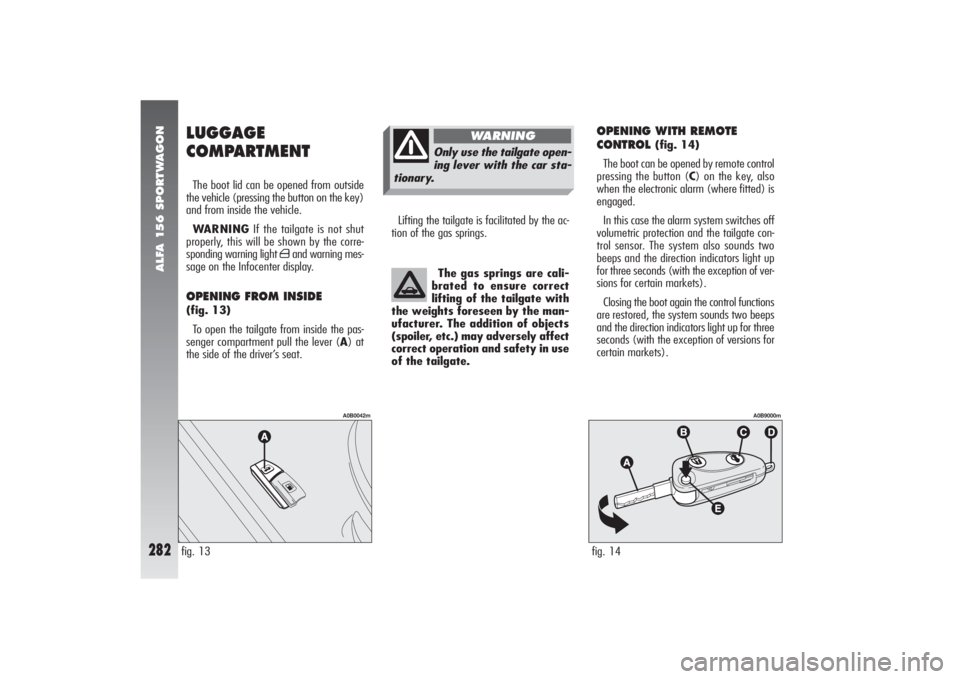
ALFA 156 SPORTWAGON
282
LUGGAGE
COMPARTMENTThe boot lid can be opened from outside
the vehicle (pressing the button on the key)
and from inside the vehicle.
WARNINGIf the tailgate is not shut
properly, this will be shown by the corre-
sponding warning light
´
and warning mes-
sage on the Infocenter display.
OPENING FROM INSIDE (fig. 13)
To open the tailgate from inside the pas-
senger compartment pull the lever (A) at
the side of the driver’s seat.fig. 13
A0B0042m
Lifting the tailgate is facilitated by the ac-
tion of the gas springs.
The gas springs are cali-
brated to ensure correct
lifting of the tailgate with
the weights foreseen by the man-
ufacturer. The addition of objects
(spoiler, etc.) may adversely affect
correct operation and safety in use
of the tailgate.
OPENING WITH REMOTE
CONTROL
(fig. 14)
The boot can be opened by remote control
pressing the button (C) on the key, also
when the electronic alarm (where fitted) is
engaged.
In this case the alarm system switches off
volumetric protection and the tailgate con-
trol sensor. The system also sounds two
beeps and the direction indicators light up
for three seconds (with the exception of ver-
sions for certain markets).
Closing the boot again the control functions
are restored, the system sounds two beeps
and the direction indicators light up for three
seconds (with the exception of versions for
certain markets).
fig. 14
A0B9000m
Only use the tailgate open-
ing lever with the car sta-
tionary.
WARNING
Page 302 of 357

TECHNICAL SPECIFICATIONS
300
fig. 3
A0B0059m
BODYWORK PAINT
IDENTIFICATION LABELOn the Saloon versions, the plate is ap-
plied in the internal part of the luggage com-
partment (3-fig. 1), while on the Sport-
wagon versions it is applied on the right-
hand internal edge of the tailgate (3-
fig. 2). The plate carries the following da-
ta (fig. 3):
A.Paint manufacturer
B.Name of colour
C.Colour code
D.Colour code for touching up and re-
spraying.
IDENTIFICATION LABELThis is located in the engine bay on the
front crossmember (fig. 4).
It carries the following identification data:
A.Space for details of national ho-
mologation
B.Space for punching the consecutive
chassis number
C.Space available for maximum
weights authorised by various national lawsD.Space for version and any supple-
mentary indications to those specified
E.Space for smoke index (diesel ver-
sions only)
F.Space for punching manufacturer’s
name.fig. 4
A0B0076m